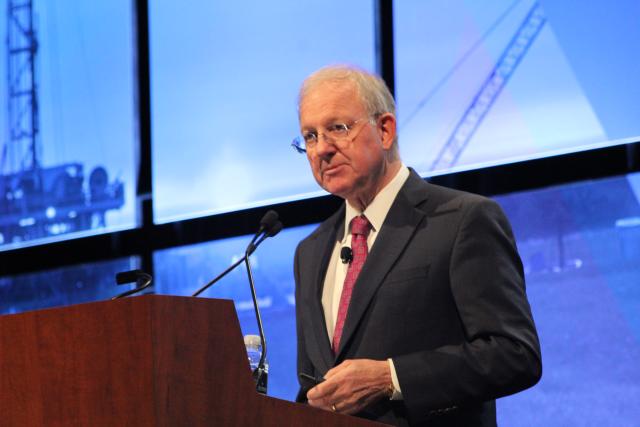
Tom Petrie, Petrie Partners, speaks at the Executive Oil Conference in Midland, Texas. (Source: Emily Patsy, Hart Energy)
MIDLAND, Texas—Speaking at Hart Energy’s recent Executive Oil Conference, Tom Petrie, chairman at Petrie Partners, laid out the multitude of geopolitical dynamics that will impact global energy markets, noting that energy price volatility is unlikely to abate.
Petrie discussed the implications of geopolitical world events on the oil and gas industry.
Petrie said that as the U.S. has increased its oil production—up to 12,800 barrels per day (bbl/d), according to the U.S. Energy Information Administration—and lessened its reliance on Saudi supply, Saudi supply has increasingly found an export market to China. Such a relationship, he explained, was indicative of the changing dynamics of energy supply partnerships around the world.
Petrie described the emergence of the “overlapping power triangles” as trade relationships among Russia, China, Iran and India.
“[These relationships] did not characterize the oil industry that we knew from the end of World War II up until 9/11, but since 9/11 it became pretty evident, and over the years it’s seemed to solidify further,” Petrie said. “That means we have yet to understand that policy makers and strategists in Washington, D.C. need to take that more into account than they usually did for over half a century. So it will be a challenge for them to do that and make decisions.”
Petrie explained that although 2011 Arab Spring brought about popular elections in North Africa and the Middle East, it also ultimately led to three failed states in Libya, Syria and Yemen. Petrie pointed to the unrest in Libya in which Khalifa Haftar is leading the rebel Libyan National Army against the internationally recognized government in Tripoli.
More fallout from the Arab Spring, Petrie said, was the creation of a “virtual” cold war between Iran and Saudi Arabia, one that he said might be intensifying as evidenced by this summer’s drone attacks by Iran on Saudi oil infrastructure.
“A little over a month ago, drones and cruise missiles honed in on the infrastructure in Saudi Arabia for processing and exporting oil,” Petrie said. “It’s certainly a heating up cold war. It’s not as cold as we once thought it was.”
Another result of the Arab Spring is the possibility of a “merger” or “elevated hegemony” by Iran over Iraq. Petrie explained that Saudi Arabia took issue with the U.S. invasion of Iraq in 2003 because of what he described as “the second order of consequence” shifting from a Sunni-led government to a Shiite government in Iraq.
Petrie said that Ayatollah Sistani has worked to keep Iranian influence over Iraq, but his efforts were diminished with the emergence of the ISIS threat in Iraq and Iranian militias aiding in the fight.
“[The militias] didn’t go home when success was achieved,” Petrie said. “They stayed around, which would be a complicating factor.”
He said the eventual death of 87-year-old Sistani could trigger an Iranian bid to have an Iranian-Shiite Ayatollah become the Grand Ayatollah.
“So, against all of that, we’ve still got a tough legacy and lots of reasons to expect continued challenges in the Middle East,” Petrie said.
Another of the challenges that he discussed was the possibility that Saudi Arabia may be looking to balance the oil markets “at any cost” with increased production levels while the U.S. continues to produce record amounts of oil. He said accommodating that growth in supply could prove to be a challenge.
“The real key for the U.S. and for Saudi Arabia as they work to achieve a price is where all that oil goes,” he said.
According to data Petrie provided during his presentation, the Americas, Asia Pacific and Europe import about 3 MMbbl/d of U.S. light crude and condensate. That amount is projected to increase to nearly 4 MMbbl/d by 2024.
“We’ve got a situation where the U.S. has doubled its production in less than 15 years,” Petrie said. “That doubling in that period of time is going to continue to present something of a challenge to both Russia and Saudi Arabia to achieve their goals of higher prices.”
While Russia and Saudi Arabia might need as much as $80/bbl WTI prices to achieve those goals, Petrie said, the U.S. market can remain competitive at prices of about $65/bbl. He said a potential trade agreement between the U.S. and China could have a positive effect on markets.
“But we still have an ongoing need for Saudi-Russian discipline, and that means the energy price volatility that we have been dealing with is going to be continuing as a challenge,” he said. “That doesn’t negate the basic fact that the U.S. position is likely to be a key competitive advantage as we work through one of the most geopolitically challenged times I’ve seen in my 47 years of serving.”
Recommended Reading
Canadian Natural Resources Boosting Production in Oil Sands
2024-03-04 - Canadian Natural Resources will increase its quarterly dividend following record production volumes in the quarter.
Par Pacific Asset-based Revolving Credit Bumped Up by 55%
2024-03-25 - The amendment increases Par Pacific Holdings’ existing asset-based revolving credit facility to $1.4 billion from $900 million.
NGL Growth Leads Enterprise Product Partners to Strong Fourth Quarter
2024-02-02 - Enterprise Product Partners executives are still waiting to receive final federal approval to go ahead with the company’s Sea Port Terminal Project.
Enbridge Advances Expansion of Permian’s Gray Oak Pipeline
2024-02-13 - In its fourth-quarter earnings call, Enbridge also said the Mainline pipeline system tolling agreement is awaiting regulatory approval from a Canadian regulatory agency.
E&P Earnings Season Proves Up Stronger Efficiencies, Profits
2024-04-04 - The 2024 outlook for E&Ps largely surprises to the upside with conservative budgets and steady volumes.





